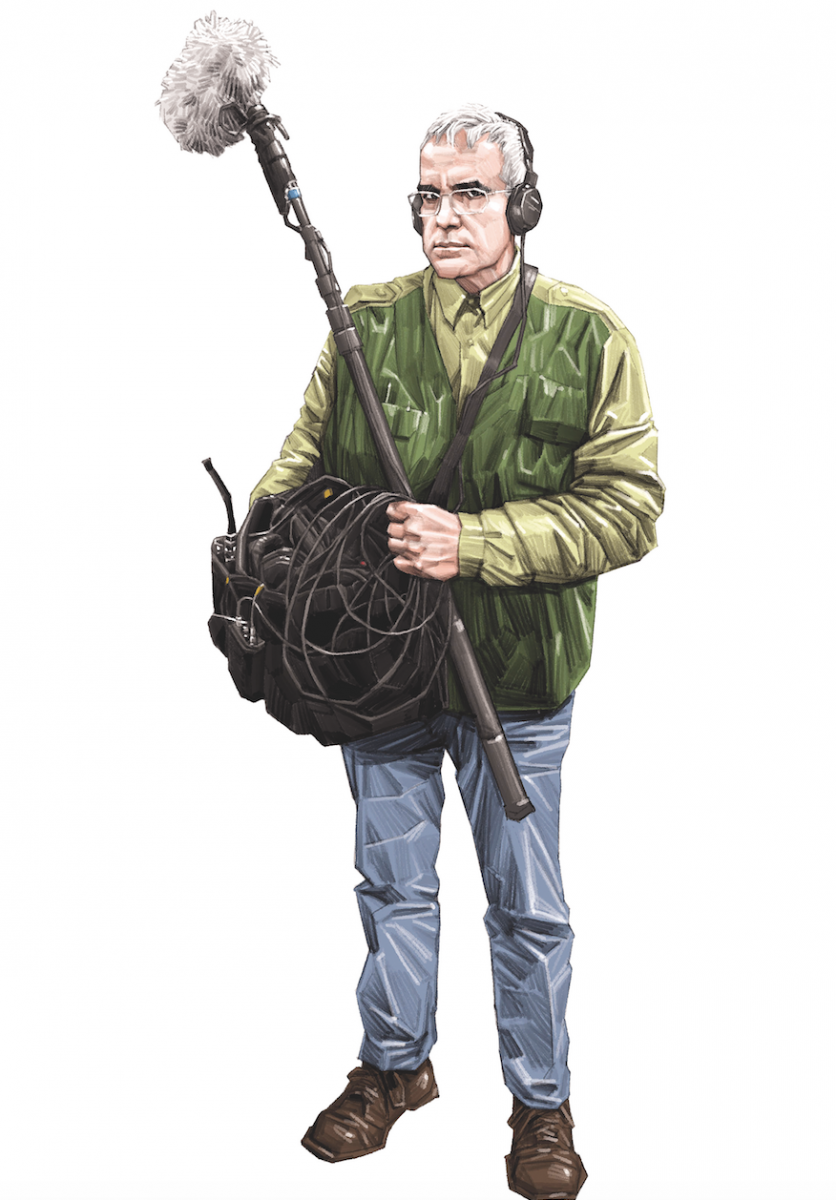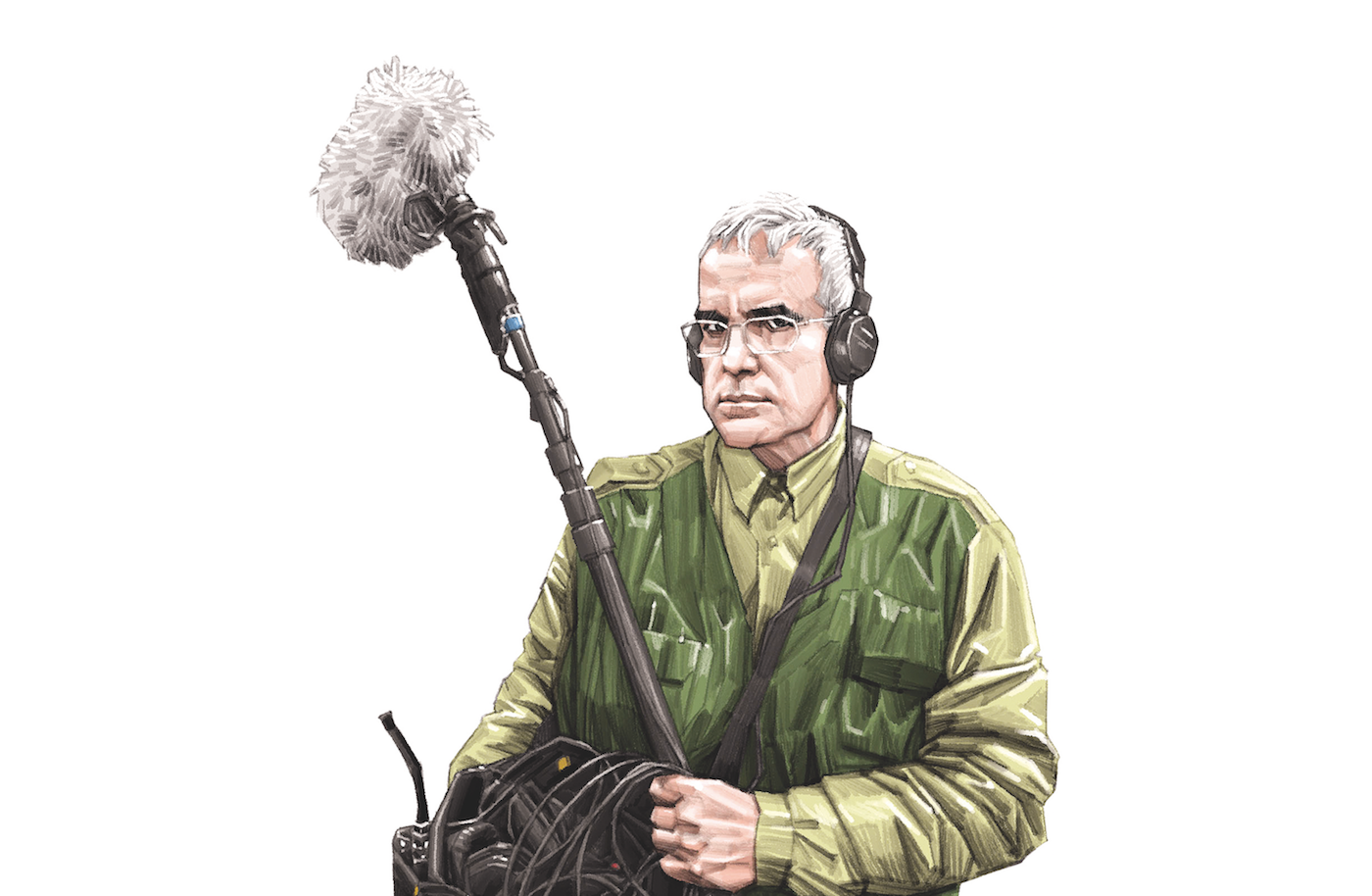Vasco Pimentel: The Listener
The Listener is a profile of Vasco Pimentel, a Portuguese sound director who believes what a film sounds like can convey the story as much as, if not more than, its cinematography. The piece was originally published in Spanish in August 2014 in Etiqueta Negra, a Peruvian magazine for narrative journalism. It has been translated and republished on Storybench with the permission of writer Sabrina Duque, editor Eliezer Budasoff, and the magazine’s founding editor Julio Villanueva Chang.
Vasco Pimentel: The Listener
By Sabrina Duque
Artwork by Luis Falen
Hardly anyone remembers the soundman after the Oscars. Some are faceless geniuses and without their audio creations we could not mourn nor remember nor fear. One soundman, Vasco Pimentel, travels the world with headphones on. Is the sound of a car more unbearable than the cries of a baby?
Since they started living together, Vasco Pimentel has asked his wife not to speak when she wakes up. Every morning, the sound director who inspired Lisbon Story, a film by Wim Wenders, requires an hour and a half without hearing a thing. When his wife forgets and starts talking, he raises his hand like a policeman stopping traffic. Stop. Silence. It’s time for listening. The wife of the sound engineer, an architect who left her life in Peru and moved with Pimentel to Lisbon, has become accustomed to watching him get up, make breakfast, and read his mail all without uttering a word.
Pimentel has given up visiting friends because they speak at the point of shouting. He has stopped going to cafes because the racket bothers him. He has created sound for over one hundred films but does not attend film festivals: “There is too much noise on the red carpet,” he says. Nor can he tolerate the murmur of a television in his own language: “It is an inflation of words whose semantic value is null and whose intonation is full of hysteria and lies.” But he likes the sound of television programs in China or India: because he does not speak those languages, the words come to him only as sounds, without understanding their meaning.
Vasco Pimentel hates the sound of noisy cars running, but unlike most, he grimaces in such a way that he seems to suffer from the worst headache when he hears an idling car. “I do not know what to do in my head when I hear the noise of a car,” he says. However, he likes “long, endless, excruciating” musical notes produced by a stream of cars passing over the metal bridge in Lisbon, the city where he was born. Each time he enters a location where the ambient noise is high, Pimentel raises hands, covers his ears with open palms, and tightens his jaws like a child stunned by the shouts of its parents. Sometimes, when he gets into someone else’s car and the radio is on, he gets exasperated and starts slapping the stereo buttons until it turns off. “The world is poorly mixed,” he says.

Vasco Pimentel is fifty-six, with a bush of silver hair, thick dark eyebrows and a drawer full of Ohropax—peace for the ears—German ear plugs at home. They are the same brand of ear plugs used by Franz Kafka to tolerate the noise during the First World War. Ohropax plugs were invented by a German pharmacist in the early twentieth century in response to the problem of increasingly burdensome noise from the industrial era. When the soundman opens his drawer to discover that there is only a box or two left, he goes out to scour the pharmacies: if he finds one that sells the brand, he buys all their whole stock. Some years ago, Vasco Pimentel concluded that the chaos of cars, noises and screams outside his house were going to damage his hearing. Since then, the Lisbon-based soundman—who has earned a living lending his hearing to filmmakers like Wim Wenders, Vincent Gallo and Manoel de Oliveira, the oldest director in the world—cannot go outside without wearing earplugs.
Our brain has evolved the ability to suppress background noise that does not interest us. At a crowded party, for example, we do not usually hear anything accurately until someone pronounces our name. In a crowded airport, we tend to hear the boarding announcements only when the time of our flight approaches. The brain’s ability to focus a person’s hearing on certain sounds and ignore those that do not interest us is known as the ‘cocktail party effect.’ When the noise bothers us, we can ‘turn it down’ to concentrate, for example, to eavesdrop on a chat between two strangers. If we are interested in a conversation at a party, background noises cease to bother us after a few minutes. “We all have a kind of filter,” says Rui Poças, a frequent companion of Pimentel’s on set. “But Vasco gets irritated because he has just heard things that he didn’t want.” Rui Poças, one of the best cinematographers in the world according to Hollywood Reporter, says that Pimentel has stopped work on a film set to ask someone to stop making a noise that he did not even know he was making: nervously tapping one’s foot, scraping a wall with one’s nails, or even chewing gum.
***
Sound engineers tend to be detail-oriented, obsessive and anonymous. Although the visible faces of the film are the actors and directors, someone who no one would recognize on the street may have been responsible for half of a film: none of us would be able to get excited about, exhaling euphoria or relief, release a sudden cry or a shudder in front of the screen if not for a sound effect chosen precisely to provoke emotion. Horror films would be harmless without a sound director: the suspense is the hysterical shriek of a violin while a woman is showering (Psycho), two repeated notes–E and F–that become louder as the camera closes in on a swimmer (Jaws), a children’s song that becomes distorted as a character falls asleep (Nightmare on Elm Street).
The dramas and romantic comedies would not make us cry or delude us without music’s power of suggestion: Rocky Balboa running through the streets of Philadelphia would not have convinced us of his spirit of excellence without the trumpets playing Gonna Fly Now for each of his steps. Leonardo DiCaprio and Kate Winslet would have only been two somewhat suicidal tourists on the bow of the Titanic if it were not for the background melody of My Heart Will Go On. Patrick Swayze would have looked ridiculous with those rays of light behind his head bidding farewell to Demi Moore if at the end of Ghost the song Unchained Melody has not been playing.

Feeling emotion during a movie is due in large part to the quiet work of a sound engineer but Hollywood has its own ‘cocktail party effect’ when it comes to soundmen. As if just background noise at a crowded celebrity party, nobody notices the names of the sound directors. Gary Summers, one of the most successful Hollywood sound engineers, has been nominated nine times for an Oscar and won four, as many as Spielberg, but he does not pose for many photos nor do we ask him how he managed to create the sound of thousands of swords clashing in The Lord of the Rings, the onslaught of water in Titanic, or the steps of soldiers in The Empire Strikes Back.
Mark Berger might sound like some English soccer player, but it’s the name of one of the sound engineers of Apocalypse Now, someone who has won the Oscar the four times he was nominated. The sound work in Apocalypse Now made many scenes memorable, like the one that opens the film: while a soldier observes the oscillating of a wall fan from his bed, we hear the sound of a helicopter, and thus the juxtaposition of sound and image convey the hallucinations of a character. That film also marked a milestone in the history of cinema. The director Francis Ford Coppola understood that sound work had contributed so much to the tenor and history of film that those responsible would no longer be considered just “sound engineers.” After the late seventies, they became known as sound directors.

On the island of silence that is his home in Lisbon, where he is safe from the noise of cars, Vasco Pimentel remembers another scene from Apocalypse Now: the cook leaves the ship and enters the jungle to find something to make his meal. First, the hum of insects and singing birds is heard. But suddenly, all the noise disappears. The cook goes on alert. We hear something moving in the grass. The tension increases with every second. Then, a jungle tiger emerges like lightning, and one is left on the verge of heart attack.
“It would have been a mistake to play the roar of a tiger before it appeared,” says Pimentel. “What you want is that it not be understood to be a tiger.” The filmmaker Robert Bresson believed that the eye is superficial and that the ear is profound: “The sound of a train whistle,” he said, “conjures up the whole station.” For Bresson, a sound should not come to the aid of an image. For Pimentel, a montage of sound where everything that one hears is seen is stupid.
The Western urban culture favors sight over the other senses but considers extreme sensitivity to sound a superpower. The ear allows us to perceive that which is not before us. Superman hears the cry of a child from hundreds of kilometers away. In the Bionic Man, the hit TV series of the seventies, Steve Austin is not only capable of lifting trucks and see details that are miles away, he is also able to hear the plans of bad guys that are very far from him. There are TV commercials that offer headphones that promise to allow us to eavesdrop on the room next door. However, those who begin using these headphones suddenly abandon them because it stuns them to hear so much.
Vasco Pimentel, who has an extraordinary sense of hearing, lives sometimes as if his gift were a curse. Not only does he dislike the noise of cars, he dislikes the cries of waiters and the murmur of conversations in restaurants, the simultaneous babble of football commentary on the radio, and fashionable songs, especially Rihanna’s. He does not suffer from hyperacusis, a syndrome that makes intolerable sounds like a phone ringing or the knocking of silverware against plates. Nor does he suffer from misophonia, a hatred of noise, which makes excruciating the sound of a pen scratching a sheet of paper. The problem for Pimentel is the noise that surrounds us like a bubble: that which we hear everywhere and that which we do not hear due to callousness or indifference.
“People hear abominable things,” he says.

One afternoon, while filming with the director Wim Wenders, Vasco Pimentel took off his headphones and walked resolutely towards some children playing loudly and that were ruining a scene. It was the nineties, and they were on a terrace of Alfama, one of the oldest neighborhoods in the Portuguese capital, trying to film a scene from Lisbon Story, a Wenders film that reflects on image and sound in the movies. Suddenly, Pimentel put his headphones over the ears of one of the children and pointed the microphone to capture the sounds coming at that terrace overlooking the Tagus river: the birdsong, the church bells, the wind in the trees, the whistle of a boat arriving at the port. One by one, the children listened and fell silent as though hypnotized: they had become accomplices of a man who had made them hear a world that was there but that they did not perceive. Vasco Pimentel had lent his ears to these children.
Wim Wenders liked the scene so much that he decided to include it in Lisbon Story, a film that deals with a director who intends to make a film alone with his camera and no one else, as if it were the first in the history of cinema. The filmmaker character films for hours and hours in Lisbon, without sound, until he realizes that his project is failing. Then he asks for help from a soundman friend—the protagonist of the film—who travels to the Portuguese capital with his suitcase and microphone to save the film. When the actor who plays the soundman in Lisbon Story traveled to the Portuguese capital, Wim Wenders asked him to become inspired by following Pimentel’s footsteps for days through the streets of the city. The Portuguese soundman, who had already worked with Wenders on The State of Things, was in reality the maniacal and passionate character that the German director wanted portrayed in his film.
When he speaks, Vasco Pimentel is as expressive as an accelerated mime and, while gesturing, his lips spout onomatopoeias. A million words come out of his mouth per hour, but they aren’t enough to say everything he wants to say. Vasco Pimentel looks like a child who has not yet learned to talk who tries to tell a story with all his body and all his sounds. Were we to use a remote control to mute the environment and watch Vasco Pimentel, we would understand what he was explaining even without hearing him. In the Portuguese empire there existed the figure of the listener, an envoy of the king who heard the complaints of his subjects far from the metropolis, and chose to tell the king what he should know. Pimentel is a listener for the film, a soundman who works to make us hear what we have stopped hearing.
It’s not only Wim Wenders who has been seduced by the obsessive, hyperbolic and passionate character of the soundman. In the world of Portuguese cinema, Pimentel is also known for his visceral and thorough link to what he hears. Maria de Medeiros, the actress who considers Pimentel “a poet of sound” rather than “a technician obsessed with technique,” recalls that Pimentel captivated his team for hours talking about a sound. Pimentel never stops working: when shooting a scene ends, he grabs his microphone and walks to the bus stop to record the sound it makes while braking, he walks to the light at the corner to record the click of the changing lights, he walks two blocks to record the sound of falling coins on the counter in a store or a salesperson talking with his client. Who knows if he’ll end up including any of these details in the background of the movie he’s filming.
In film, hardly anyone will perceive the dialogue happening in a store two blocks from where the action is, but the sounds will be there to help build a sense of reality, a sense that is not always obvious. That’s the job of a soundman. The sound of the lightsabers in Star Wars was achieved with the sound of a TV and the hum of an engine. The famous Tarzan yell was achieved by mixing the voice of the actor with a barking dog, the howl of a hyena, and a soprano singing a C note. To make The Exorcist, the director reinforced the emotional impact of the film by including in the soundtrack swarms of bees, noises of pigs being slaughtered, cats meowing, and a roaring lion. In his book Sinister Resonance, the musician David Toop speaks of abstract sounds that Stanley Kubrick used in The Shining: the crunch of the snow, the bouncing of a ball, the sound of a child’s tricycle as it moves across the floors of the hotel, distant echoes of an old song. All this, according Toop, causes a cumulative emotional effect so overwhelming that wondering if it’s real music, noise, ambient sound, or good or bad music no longer makes sense. Vasco Pimentel fabricates an acoustic environment and plays with the power of sound to evoke what we cannot see.
Last spring, Pimentel was uneasily dealing with a question: what would a psychoanalyst’s office installed in the belly of a whale sound like? For his new film, filmmaker Miguel Gomes had commissioned Pimentel to design, among other scenes, the sound of an office in the belly of an animal. Pimentel thought of the reverberations of voices inside clinics. Over the winter, for the same movie, he had been recording the songs of caged birds and thinking about how to add sound to the reinterpretation of the myth of Jonah. “Vasco is a musician in the way he looks at the world,” explains his friend Rui Poças. “In a sense, he is a musician in the wrong place. But if he were a musician, he would be a filmmaker in the wrong place.” Pimentel feels every sound for its music or its significance.
For ordinary men and women, the most unbearable noise is not the highest pitch: it is the cry of a baby. According to a study published in the Journal of Social, Evolutionary, and Cultural Psychology, it’s the most disturbing sound because it is almost impossible to be indifferent to it: when that alarm sounds, we are endowed with a ‘psychological spring’ to stop what we’re doing. Years ago, another study by a British university asked through a web survey for a list of over thirty sounds, ranking them along six levels from ‘not so bad’ to ‘unbearable.’ The sound of a baby crying was third after the sound of someone vomiting and the feedback from a microphone. According to the scientists, if the crying baby exasperates us so much it’s because of a biological reaction for the conservation of the species.

According to Vasco Pimentel, the restlessness that a crying baby provokes in us is related to the evocative power of sound and its unpredictable character: “It is because of the very potent power of the ear—and no other sense—that it can arouse fantasy, fears, memories. The crying of a baby immediately makes you think: ‘It’s a helpless being, it’s suffering, it does not possess the language to communicate, and it needs something that I do not understand because its language is purely cries.’ ”
Pimentel, who works manipulating the emotional power of sounds, can hear the crying of a baby and understand what it evokes in people: that means it doesn’t bother him as much. When any of us hears a baby cry, what bothers us is its incessant duration and not knowing what it is about. The sound of a child that shouts and cries does not have an identical pattern nor frequency, nor rate, nor development, nor anything, Pimentel explains: “You do not know what will happen, and that irritates people.” On the other hand, for him, who understands sounds for their music in addition to their meaning, the most unbearable of all is the sound of a stopped car with its engine running because it seems to him absurdly stupid and repetitive.
“All sounds are cyclical. But the cycle of a stopped car that goes trrrrrrrrrrrrrrrr is particularly stupid. It is so short that four times every second it repeats the same cycle: taca-ta-ta ta-taca-ta-ta-ta-taca ta ta ta.” Nothing new ever happens, there are no expectations, no variations, no surprise there. If most of us are bothered by a crying baby and a car engine does not bother us, says the soundman, it is because we are accustomed to repetition, because that’s what the world imposes on us. The music you hear in a bar, in a cafe, in a taxi, a YouTube ad, Pimentel recalls, corresponds to the noise made by a stopped car with the engine running. We have been formatted to feel comfortable with the repetitive. Unpredictability irritates us or disturbs us. It makes us feel insecure.
For most people, smells can transport us to the past: the son of a smoker returns to his childhood after inhaling the smoke of a brand of cigarettes smoked by his father. And the scent of a stranger in an elevator can paint a picture of a woman we have forgotten. Memories enter Vasco Pimentel through the ear, the first sense used by a newborn. From the age of four and a half months, we begin to hear the sounds outside of our mother’s belly. A few years ago a study by Harvard University claimed that listening to baroque music stimulated more neural connections in children. The ‘Baby Mozart effect’ then became fashionable: some pregnant women rushed to put headphones on their bellies with the illusion of having babies become smarter by making them listen to the Magic Flute from the uterus.
Half a century before that trend, Vasco Pimentel and his five siblings grew up listening to compositions of the XIV, XV and XVI centuries. The music of the Middle Ages and the Renaissance lulled baby Pimentel to sleep when he’d hear, coming from the first floor of a modern house in a remote district of downtown Lisbon, the baroque music played by his parents. Duarte Pimentel and Tita Lamas were a couple of musicians who devoted themselves for decades to musical archeology: rescuing scores of Portuguese Baroque, commissioning the reconstruction instruments that had been missing for centuries, and joining other musicians to rescue sounds and melodies that no longer existed. While their classmates listened to the Beatles, the Pimentel siblings were listening to music composed before the birth of Bach.

Some time ago, a team of scientists from five countries tested a drug that returned to an adult’s brain the plasticity of child’s. They were investigating absolute pitch—the capacity to recognize by memory the note that makes up any noise, from the sound of a falling pot to the sound of two glasses during a toast—and wanted to restore in their subjects the learning potential they had before the age of seven. After two weeks of exercises with the musical scale, subjects who had taken the drug valproate, all without previous knowledge of music, ended up with absolute pitch. The ability to recognize or sing any musical note without any reference is more of a linguistic ability than a musical one, and it’s related to auditory memory, with what we heard in our childhood, with the stimuli we received as children.
Today researchers discuss an acoustic version of the dilemma of the chicken and the egg: Which came first? Language or music? The most controversial argue that spoken language is nothing but a kind of music, that babies first hear the sounds of language and only later recognize their meaning. What we call music, they say, is just playing creatively with sounds. But nobody teaches us how to listen in the same way that we are taught how to speak, read and write.
Today two of the six Pimentel brothers makes a living with their prodigious ears. The younger one is able to tune pianos in minutes thanks to his perfect pitch. Vasco Pimentel can remember the exact note that starts an opera that he has not heard in thirty years and he creates soundscapes for films and plays. “Musical notes,” he says, “are no more than a simplification: twelve compartments for sorting and storing all the sounds of the world.” The soundman credits his musical ability for his facility with learning languages: Pimentel speaks Portuguese, German, French, Spanish, Italian, and a little Czech. The latter, he says, he learned listening to recordings in Czech while riding the subway in Paris during one of his filming trips. When he hears the world and when he works composing sound, Vasco Pimentel organizes the sounds and dialogues in musical form. From the editing booth, he watches the computer monitor as if looking at an empty landscape. He hears a noise and looks to combine it with another. He becomes obsessed with finding the right tone as if he’s composing a song.
The acoustic memory of a soundman is not a melodious music box: it’s a Tower of Babel of memories as confusing as they are unprecedented. From his travels around the world, Vasco Pimentel remembers how Muslims were called to prayer in Sarajevo, Bosnia: “They were melancholy and vibrant chants in Slavic voices on the verge of the falsetto of Italian bel canto: Russian Bellini with Arabic lyrics.” He remembers the sound of bells tolling in Varanasi, India: “There were hundreds of bells without regular rhythm, all in different tones, one stroke each, within a constant hum of thousands of bicycle bells.” Pimentel cannot forget the music of the cellphones in Tessalit, Mali: “Everyone moves around with their phone on playing little cellphone electric guitars music. While the people walked, their music would mix and unmix in space and time.” The soundman evokes the silence of St. Petersburg, Russia: “There was a wounded sparrow, fallen to the white and frozen ground, crying alone, lying in the snow that kept falling.” Vasco Pimentel remembers that it was there that he first understood silence. “Silence,” he says, “is all that keeps ringing around a dying sparrow.”
Like all soundmen, Vasco Pimentel is a creator of sounds and of silence. In the most famous work of the composer John Cage, called 4’33, an orchestra interprets blank sheets of tablature for four and a half minutes. The audience only hears its own silence and the sounds of the theater. Before composing the piece, John Cage had visited Harvard’s anechoic chamber, a room isolated from all external sound sources and designed to absorb all sound waves. Cage entered the chamber expecting to hear silence but found that in there he still heard two sounds, one high and one low. The sound engineer in charge explained to him that the high sound he heard corresponded to his nervous system and the low sound was his blood circulating. That led Cage to compose 4’33. According to the Guinness Book of Records, a similar room, the anechoic chamber of Orfield Laboratories in Minneapolis, U.S.A., is the quietest place in the world. Those who enter and close their eyes in the anechoic chamber perceive no sound. Locked behind three heavy doors, most visitors feel distress and ask to leave. Silence causes pleasure, but a prolonged absence of sound overwhelms us even more.
The playwright Harold Pinter said that silence forces the audience to contemplate what a character is thinking. In Tabu, another film by the director Miguel Gomes, there is an entire block where the characters talk and whisper and scream at one another, but the public never hears their voices. They only hear the voice of a narrator telling them what they’re seeing. What is heard is the barking of dogs, the dragging of chairs, the grunts of motor bikes through the mountains, and rock-and-roll songs flowing from a radio. Vasco Pimentel had deleted the dialogue of the characters and made the ambient sound as a backdrop to play with the idea that we are uncertain of the words we hear or say, and that we can only reconstruct them.
“The sound in a film acts on you in a way that is metaphorical, secret, unconscious, painful, pleasurable. But these are secret areas of our psyche,” he says. “It is not information that provided by an image or dialogue.” To make us aware of silence in a scene, Pimentel uses the distant presence of an everyday sound: a character hears a dog barking a kilometer away. In that world, there is nothing between the character and the dog barking in the distance. The dog is alone. In silence. Without anyone. It is the Platonic state of Pimentel without earplugs. As he likes to be every day, every morning, after he wakes.
Etiqueta Negra is a magazine for narrative journalism based in Lima, Peru. More information here. Thanks to Sabrina Duque, Eliezer Budasoff, and Julio Villanueva Chang for permission to republish a translation of this piece.
- NICAR: With the right tools, anyone can be a data journalist - March 11, 2019
- Northeastern J-school alumna Rachel Zarrell makes Forbes’ “30 under 30” - December 4, 2017
- How we built an interactive graphic using carcinogen data from the W.H.O. - November 12, 2015





